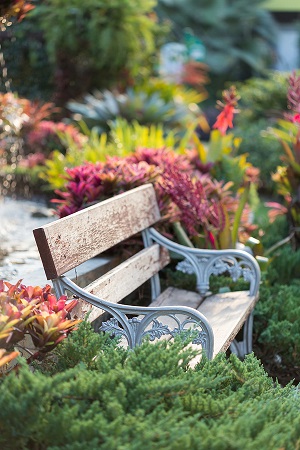 Gardening benefits your health and well-being in so many ways and appeals to all the senses. Many people are turning to “sensory” gardens to enjoy the stimulation you can get for touch, sight, smell and sound. It’s easy to achieve and satisfying to create.
Gardening benefits your health and well-being in so many ways and appeals to all the senses. Many people are turning to “sensory” gardens to enjoy the stimulation you can get for touch, sight, smell and sound. It’s easy to achieve and satisfying to create.
Today, many care facilities are using sensory gardens for their patients. A stroll through the features it offers can relax and calm patients – and studies indicate it helps those children with autism and other disabilities to better process their thoughts and actions.
When choosing plants for a sensory garden, remember to design and choose the plants in the garden in a way that appeals to all five senses. For example, you’ll want to encourage visual stimulation by colors.
Keep in mind the seasons and group or plant them accordingly for maximum benefit. Butterflies and birds are attracted to colorful plants and flowers – and provide extra sensory stimulation.
Incorporate sound in your sensory garden by adding plants which project sounds, such as rustling of leaves or ornamental grasses that make calming sounds when the wind blows through.
Water fountains and wind chimes are also great additions for sounds in the garden space. You can create a beautiful and calming area by strategically placing them where they can be most enjoyed.
Choose plants for smell that naturally release their scent into the air. Consider roses, lavender, mint, honeysuckle and violets for your scent additions to the garden space. The natural scents can calm anxiety and stress much faster than over-the-counter medications.
Plant a wide range of scented plants – from intense smells to very gently scents. You can also find many plants for your scent garden which do well in containers and can be placed strategically on the porch or patio.
Your sensory garden should include plants which stimulate taste. Herbs such as mint, basil, rosemary and lemon verbena can be used in many recipes or simply bring indoors to enjoy their beauty and scent.
Many herbs and flowers are good to dry and make into bowls of potpourri that you can enjoy all year round. Edible flowers make great garnishes to your meals and beautiful additions to your sensory garden.
Be sure to know which flowering plants are edible and which are not. You may want to use labels (sticks with labels to place in the soil) to alert people which can be tasted. Tactile stimulation (touch) can come from many garden sources, including Cape sundew. It’s a sticky, but colorful plant and adds even more interest in a garden because it’s carnivorous.
Yarrow can be touched – its leaves are soft, but the flowers are stiff. Feather grass, coneflowers and many other plants can be a good way to get children to explore all aspects of their senses – and add beauty to any space.